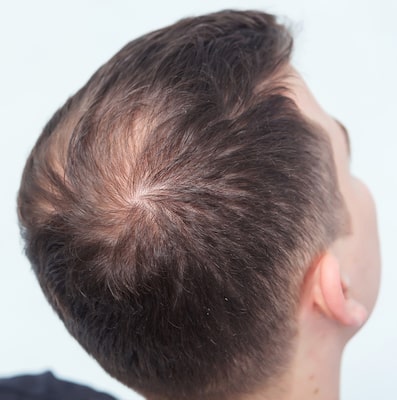Male Pattern Baldness – Why it Happens
Male hair loss, which is also known as male pattern baldness, is considered to be the most common type of hair loss in male patients. In fact, the U.S. National Library of Medicine claims that more than 50% of all men (over the age of 50) will find their scalp impacted by male pattern baldness at some point in their lives. What is the cause of male hair loss? What can be done treat the issue? Take a look below to learn the reasons why male pattern baldness (MPB) happens to men.

Male Pattern Baldness – Reasons for the Condition
One of the main causes of male pattern baldness is genetics which means the patient has baldness in their family history. Researchers have found that MPB has an association with androgens (which are male sex hormones). One of the many functions of androgens is regulating the growth of hair. Each individual hair on the scalp has a growth cycle but male pattern baldness causes the growth cycle to weaken. In turn, the hair follicle shrinks to the point that it produces hair that is finer and shorter in appearance and texture. The hair growth cycle, for each hair, will eventually stop and there will be no new hair growing to take its place.
In order to accurately determine the extent of the MPB suffered by the patient, the doctor will examine the pattern of hair loss on the scalp. The medical professional will also conduct a full medical history and medical exam to see if there are any other health reasons for the balding or thinning areas on the scalp beyond male pattern baldness.
When and How Does MPB Occur in Male Patients?

There are some people who begin to experience male pattern baldness as early as their teenage years. However, it most commonly occurs in adult men and the chances of male pattern baldness occurring increase with each passing year. As mentioned above, genetics do play a big role in developing MPB since men with close relatives with the condition are normally considered to be at a higher risk.
Men who are seeing some loss of hair, at either the crown of the head or at their temples, might be experiencing male pattern baldness. The appearance could be seen as a bald spot or as a “M” shape that forms as the hairline continues to recede. Depending on the extent of the condition, the hairline can continue to experience receding until a good portion of the hair is gone (or even all of the hair is impacted by the receding of the hairline).
How to Treat Male Pattern Baldness
Before patients turn to a surgical procedure to treat the balding areas of the scalp, they often ask about medical treatments that can address the issue. The FDA has approved two medications for hair loss that are quite popular with patients:
- Minoxidil, which is also known by the brand name Rogaine, is a topical treatment that can be purchased over the counter as either a foam or liquid spray. Minoxidil is a vasodilator that causes the blood vessels to dilate, under the skin of the treated area, which results in the flow of blood in the body increasing due to blood vessel dilation. The product results in a longer hair growth cycle and a larger amount of hair coverage on the scalp.
- Finasteride, also known by the brand name Propecia, is a prescription oral medication for the treatment of MPB. Finasteride slows down the hair loss of a patient and it also stimulates new hair growth on the scalp. The treatment lowers DHT (dihydrotestosterone) levels in the body. DHT is an androgen in the body that shrinks hair follicles and activates hair loss by making the hair growth cycle shorter than usual. The hair will become thin and brittle and fall out at a faster rate.
Patients that want to have a surgical hair loss treatment can undergo a hair transplant to address the balding and thinning sections on the scalp. Follicular unit extraction (FUE) hair transplant is when a surgeon individually removes hair grafts from the donor area of the scalp (which is often the back and sides of the scalp). The hair grafts that are removed by the surgeon are then transplanted into premade incisions in the scalp. These hair grafts will promote the growth of new hair and provide the patients with a fuller and more youthful looking hairline.
While there are treatments for male pattern baldness, patients will not know their best option until they schedule a consultation appointment with a board-certified surgeon who is experienced in diagnosing and treating hair loss. The doctor will examine the scalp to identify the reason for the loss of hair on the scalp as well as determine the best treatment option for the issue of male pattern baldness suffered by the patient.
– MA